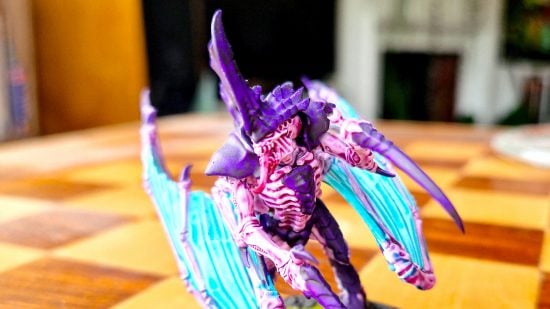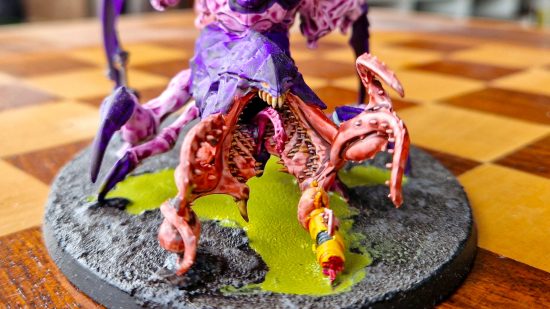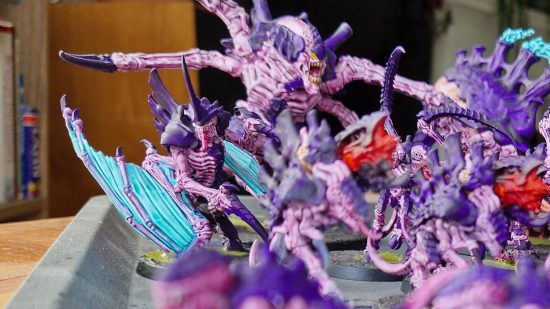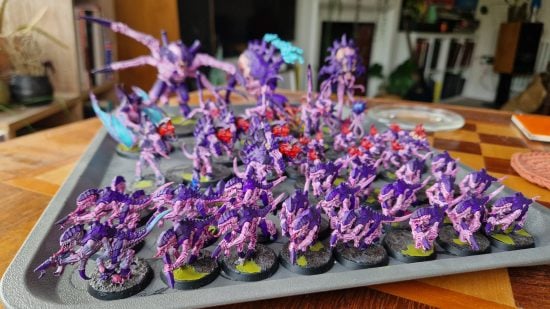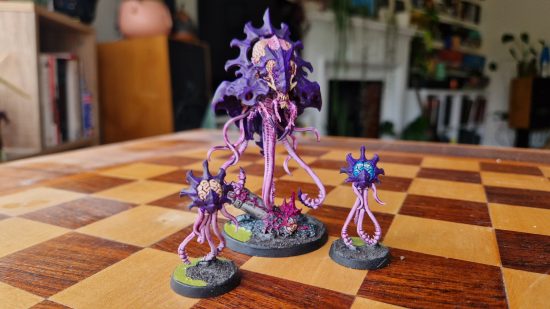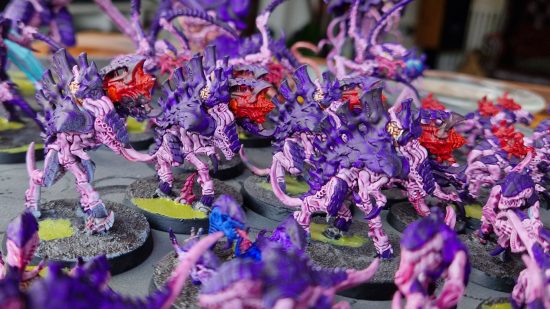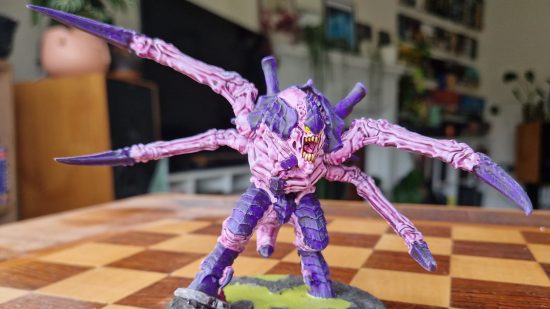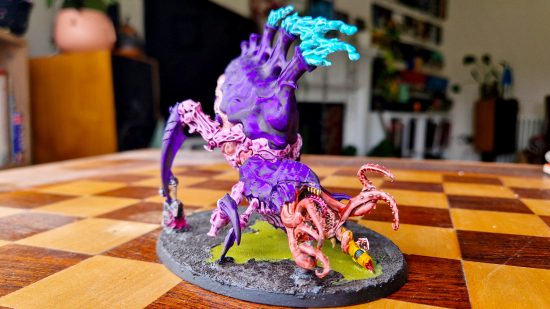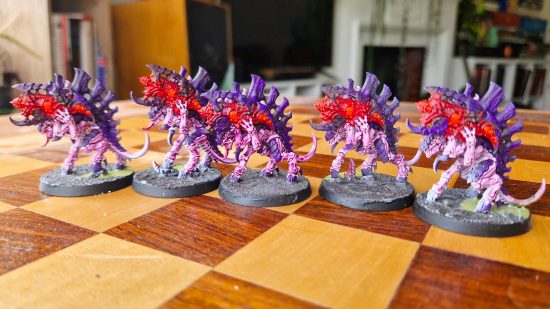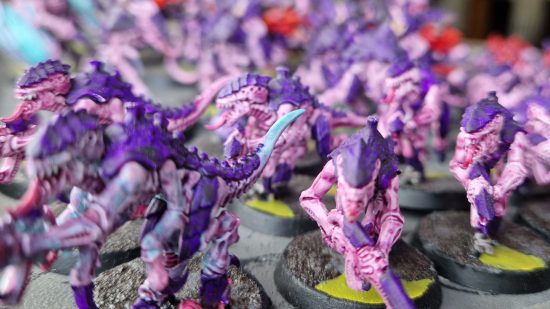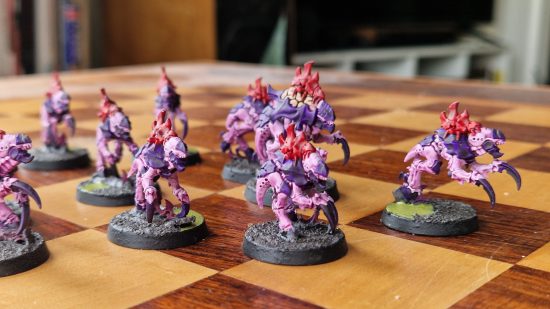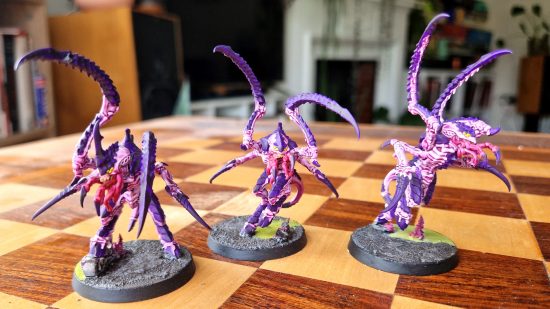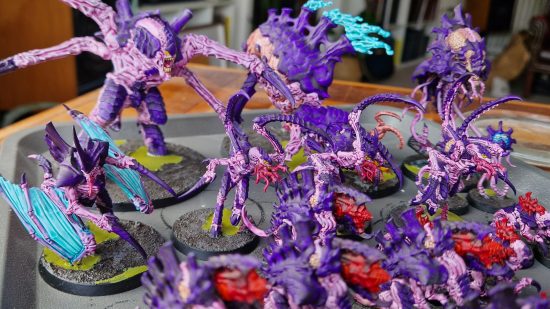OK, I get it – painting the Warhammer 40k Leviathan Tyranids models with Contrast paints isn’t exactly a revolutionary, existential discovery on a par with, say, Newtonian physics, the unravelling of the human genome, or the moment you first realise those little paper ketchup pots at McDonalds pull out to become bigger ketchup pots. The 40k 10th Edition launch box’s new Tyranids seem almost custom-made for these miniature paints, and I’m far from the only one who’s noticed.
After all, Contrast – Games Workshop’s range of slightly goopy, specially formulated miniature paints intended to provide a base color, a recess shade, and highlight in one coat – was always perfectly suited to small, craggy, textured, organic areas, such as the chitinous alien hides of Warhammer 40k Tyranid models.
Other Warhammer 40k factions also offer up strong candidates for painting with Contrast. I’ve had satisfying results with my Death Guard, the crinkly pants on the new Astra Militarum infantry troopers, and even my Horus Heresy Space Marines (Imperial Fist Contrast paint is straight up warpcraft, I’m telling you).
But none seem quite as perfect for Contrast painting as the flowing, biological bits and segmented claws of the fearsome ‘Nids – and none of these experiences has impacted me as much as the time I’ve spent with the brand new Tyranids models in the 10th Edition launch box Leviathan.
See, when painting miniatures, I’ve historically tended to be what you’d call meticulous to the point of maddening inefficiency. The time it takes me to finish a given project can extend almost indefinitely, as I flit from unfinished project to unfinished project, always obsessing over a given detail until I get bored and move on, leaving the unit barely half done. Since re-entering the world of Warhammer 40k in 2017, I’ve only fully painted one of my ten total armies, and even that’s only barely 2000 points’ worth.
These Tyranids? I finished the whole lot (bar a spot of basing) in a couple of weeks – maybe about 12-14 hours of total painting time – and to what I’d consider a decent, above average tabletop standard, too.
Picking out a simple two-tone scheme (one color for the legs, faces and underbellies, and another for the hard chitin on the feet, backs, and claws) covers 90% of the planning straight away, and from there all you need to do is set up your station, stick on a podcast, and, well… Contrast paints go brrr!
It’s a simple pleasure, that efficiency, but it was remarkable how keenly I noticed the difference from my normal hobby sessions – and I don’t think I’m the only one in this spot.
During the Q&A after one of the Games Workshop presentations at Warhammer Fest 2023, a fan asked Warhammer Community supremo Eddie Eccles if GW would consider making Warhammer models less detailed, because painting them all was becoming too tiring.
There was general wry chuckling at the questioner’s expense, and Eccles’ answer understandably boiled down to “er, no” – but, as someone who has a lot of minis to paint all the time, I wasn’t laughing – I could relate.
In olden days, when sculpting was all by hand and plastic molding couldn’t handle much fine detail, it was comparatively quick and easy to paint a lot of models to a basically good standard.
Now, when even the lowliest Space Marine battle brother has a wrist-mounted auspex panel and belt-hanging reliquaries and seventeen custom pouches, the time and painting stages simply add up, and up, and up.
As Uncle Atom of the venerable Tabletop Minions YouTube channel rightly says, you can and should learn to only paint the details you have the energy, time, and inclination to paint.
Only the starkest highlights will be visible at tabletop distance, after all. But, when those beautiful little sculpted details are winking at you from all over the model, it can be a real wrench leaving them hidden in a plain base color.
The blessing in painting these ‘Nids was that it freed me from that omnipresent buffet of angular, multi-toned, artificial ornamentation that’s present in almost every army, especially those in the Imperium of Man. Contrast is great for flesh and bone – and Tyranids are all flesh and bone!
And so, as my little Termagant factory whirred away, splashing bellies with Magos Purple and back-armor with Leviathan Purple at (for me) breakneck speeds, I found myself remembering that Warhammer Fest Q&A, and taking sudden pleasure in the fact that, for once, here was a legit entire army that I would be able to finish before I got bored.
What else could I paint in 100% Contrast, I wondered? My long-neglected Skaven? Those gorgeous new Seraphon for Age of Sigmar? My half-finished Tau 40k army in old-school ochre?
That moment of discovery has already come for many painters online, I know – the excellent Vincent Knotley, for example, has done marvellous things with multicolor contrast schemes in the past, and has just completed tutorials on Emperor knows how many Termagants, each with their very own unique scheme.
But for me, it was the Leviathan Tyranids – especially the Termagants, the Screamer Killer, and the unquestioned best models in the box, the Von Ryan’s Leapers – that finally imprinted the joys of Contrast painting into me.
And, in the process, I came to love these flint-eyed, hive-minded apocalyptic insectoids too, just a little bit. Emperor knows how, but maybe you’ll find the same when you crack open your Leviathan box.
GW tells us there are a lot more new Tyranids on the way, so you can count on at least some of my newly beloved bugs making it to Wargamer’s Facebook and Twitter – if that’s something you want, follow us. In the meantime, if you’re considering scooping the box, check out our Warhammer 40k Leviathan review by Tim Linward, or catch up with all the brand new 10th Edition rules in our full guide to Warhammer 40k abilities.
